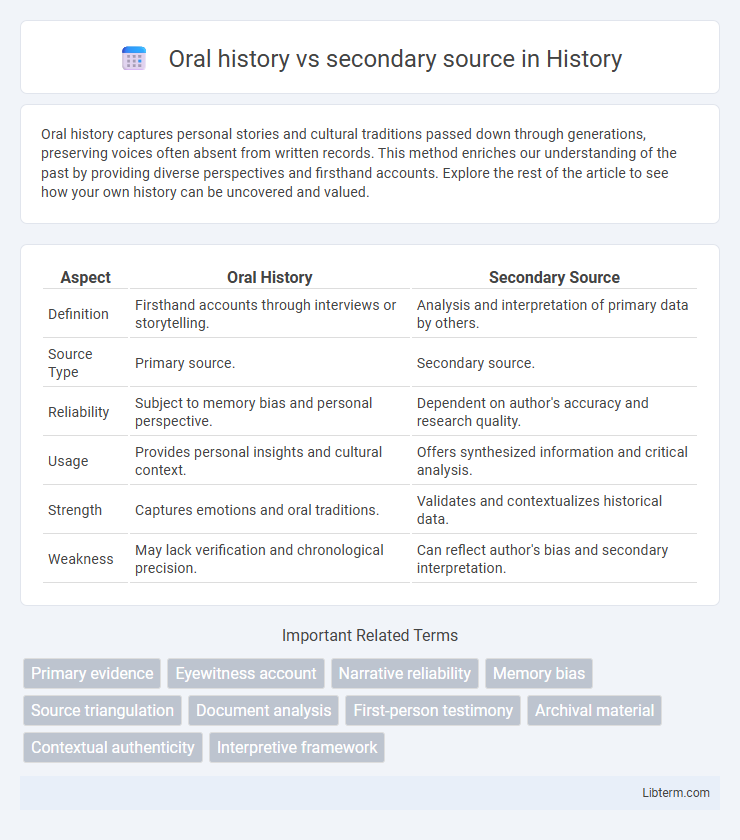Oral history captures personal stories and cultural traditions passed down through generations, preserving voices often absent from written records. This method enriches our understanding of the past by providing diverse perspectives and firsthand accounts. Explore the rest of the article to see how your own history can be uncovered and valued.
Table of Comparison
| Aspect | Oral History | Secondary Source |
|---|---|---|
| Definition | Firsthand accounts through interviews or storytelling. | Analysis and interpretation of primary data by others. |
| Source Type | Primary source. | Secondary source. |
| Reliability | Subject to memory bias and personal perspective. | Dependent on author's accuracy and research quality. |
| Usage | Provides personal insights and cultural context. | Offers synthesized information and critical analysis. |
| Strength | Captures emotions and oral traditions. | Validates and contextualizes historical data. |
| Weakness | May lack verification and chronological precision. | Can reflect author's bias and secondary interpretation. |
Introduction to Oral History and Secondary Sources
Oral history captures firsthand accounts and personal experiences directly from interviewees, providing unique primary source material that reveals perspectives often absent from written records. Secondary sources interpret, analyze, or summarize primary data, offering context and scholarly evaluation of historical events based on previously collected information. Understanding the distinction between oral histories and secondary sources is essential for accurate historical research and comprehensive analysis.
Defining Oral History
Oral history is defined as the collection and preservation of firsthand testimonies from individuals who experienced historical events, providing unique personal insights often absent in written records. Unlike secondary sources, which interpret or analyze primary data such as documents or artifacts, oral history relies on direct spoken narratives captured through interviews or recordings. This method enriches historical research by offering diverse perspectives and preserving memories that are otherwise undocumented.
Understanding Secondary Sources
Secondary sources analyze, interpret, or summarize information originally presented in primary sources like oral histories, offering broader context and critical evaluation. These sources include scholarly articles, biographies, and history textbooks that draw on firsthand accounts to provide synthesized insights. Understanding secondary sources enables researchers to grasp the significance and implications of oral histories within larger historical narratives.
Key Differences Between Oral History and Secondary Sources
Oral history involves firsthand accounts collected directly from individuals who experienced or witnessed events, providing unique personal perspectives and nuanced details not found in written records. Secondary sources analyze, interpret, or summarize primary data, relying on previously published materials rather than original testimonies. The key difference lies in oral history's use of direct testimonies as primary evidence versus secondary sources' dependence on existing interpretations and analyses.
Advantages of Oral History in Research
Oral history provides firsthand accounts and personal perspectives that often fill gaps left by secondary sources, offering richer, more nuanced insights into historical events. It preserves cultural heritage by capturing voices and experiences of individuals who may be underrepresented in written records. Researchers benefit from oral history as it allows for the exploration of subjective experiences and emotions, enhancing the authenticity and depth of qualitative data.
Limitations of Oral History
Oral history presents limitations such as potential bias, memory distortion, and selective recollection from interviewees, which can affect the accuracy and reliability of the information. Unlike secondary sources that undergo editorial scrutiny and cross-referencing, oral histories often lack verifiable evidence and standardized documentation. This makes oral history less consistent for academic research but valuable for capturing personal perspectives and cultural narratives.
Reliability and Credibility: Oral vs Secondary
Oral history offers firsthand accounts directly from individuals who experienced events, enhancing authenticity but sometimes risking inaccuracies due to memory distortion or personal bias. Secondary sources synthesize information from multiple primary accounts, providing broader context and verification but potentially introducing interpretation errors or author bias. Evaluating reliability involves assessing the immediacy of oral testimonies against the corroborated yet interpreted nature of secondary analyses.
The Role of Memory and Interpretation
Oral history relies heavily on the personal memory and subjective interpretation of individuals recounting past events, which can introduce unique perspectives but also potential biases or inaccuracies. In contrast, secondary sources synthesize information from primary accounts and other evidence, often providing a more analyzed and contextualized understanding of historical events. The role of memory in oral history creates a dynamic, living narrative, while secondary sources offer a broader, more distanced interpretation shaped by scholarly methods.
Integrating Oral History with Secondary Sources
Integrating oral history with secondary sources enriches historical research by combining firsthand personal narratives with scholarly analysis, offering deeper contextual understanding. Oral histories provide unique primary insights that complement and challenge the interpretations found in secondary sources, enhancing the accuracy and diversity of historical accounts. This multidisciplinary approach allows researchers to cross-verify information, fill gaps in written records, and capture lived experiences often omitted from traditional archives.
Conclusion: Choosing the Right Source for Research
Selecting the appropriate research source depends on the study's objectives and the type of information required. Oral history provides firsthand accounts and personal perspectives that enrich qualitative analysis, while secondary sources offer synthesized data and contextual interpretation essential for background understanding. Balancing both sources enhances research validity, ensuring a comprehensive and nuanced exploration of the topic.
Oral history Infographic

 libterm.com
libterm.com